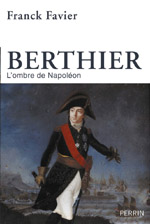History Prizes 2015
 FIRST EMPIRE PRIZE
FIRST EMPIRE PRIZE
Franck FAVIER, Berthier, l’ombre de Napoléon, Paris, Editions Perrin
Davout, Lannes, Murat, Ney, Lefebvre… these are all well-known figures, synonymous with the dashing glory of the Napoleonic epic. Strangely, Berthier rarely appears in lists of this sort, as if he had not played an active role in the Emperor’s successes and failures. And yet, for eighteen years, he was the Marshal ’eminence grise’, following Napoleon in all his campaigns, faithfully transcribing and transmitting his orders, day and night. And the Emperor rewarded him handsomely, with positions, honours and wealth, though Napoleon never really appreciated Berthier as a man.
The Major General has often been considered as two-dimensional, a mere conduit of orders. There is also the (groundless) accusation that he betrayed Napoleon in 1814, and Berthier was to die in mysterious circumstances. Beyond this he is poorly known. His life before Napoleon – his service in the armies of Louis XVI in America and during the Revolution, and his close relations with La Fayette, Noailles and Rochambeau – is often forgotten. And yet, outside the spotlight of the glory of the Empire, the man himself was complex and fascinating, with his passionate love for an Italian marquise, his marriage to a Bavarian princess, his life as a doting father and manager of a real estate empire without equal in Imperial France.
SECOND EMPIRE PRIZE
Viviane DELPECH, Abbadia, le monument idéal d’Antoine Abbadie, Rennes, Presses universitaires de Rennes
The Château d’Abbadia was built by Eugène-Emmanuel Viollet-le-Duc and his colleague Edmond Duthoit on a wild Basque promontory in Hendaye in the period 1864-1884 for the scientist/explorer Antoine d’Abbadie. With its medieval silhouette, English landscape garden, exotic plants and decor, Neo-gothic, Oriental, and Ethiopian furnishings, the building perfectly matches the patron.
As a rich landed investor, d’Abbadie used his vast wealth to build this sumptuous residence. And his financial independence made it possible for him to give free rein to his aesthetic desires. The talents of the architect did the rest in the creation of this perfectly hybrid structure, whether in its architecture, its decoration, or furniture, all designed for either study, worship or the highlife. Because of this blend of interest in letters and in luxury, Abbadia is the perfect illustration of the lifestyle of certain elite figures of the Second Empire.
D’Abbadie was elected Correspondant of the Académie des Sciences in 1852 and Member of that institution in 1867. He furthermore shared a passion for the Basque language with Prince Louis-Lucien Bonaparte and with the Emperor Napoleon III, who agreed to lay the symbolic final stone. It was for this reason that the château included an imperial suite with especially sumptuous furniture and furnishings.
This book, born from the author’s doctoral thesis, gives a full account of an almost completely forgotten example of Viollet-le-Duc’s civic architecture. Furthermore, not only is the house complete, it is also a rare example of a complete Second-Empire architectural ensemble.
Viviane Delpech received a Fondation Napoléon research grant in 2010 for her thesis on the Château d’Abbadia.
JURY PRIZE
Hervé DUMONT, Napoléon. L’épopée en 1 000 films, Lausanne, Ides et Calendes
“This encyclopaedic filmography of films worldwide on Napoleon and his times is not only a first, it is also unique for its uncompromising commentary and rare collection of illustrations.
The marks that Napoleon and Revolutionary (and later Imperial) France left on the whole of Europe have inspired a thousand or so cinema and television films (including series and mini-series), beginning in 1897 and running up to today. And they come from all over –ranging from Madrid to Stockholm and Moscow in Europe, and from the US, Canada, Egypt, Syria, Mexico, Argentina, and Brazil worldwide, to mention but a few. Adored, hated, forgotten or lost, about fifty percent have never been seen in France.
In every country and for every decade, Napoleon occupies a specific place, whether fascination, adulation, or rejection. Every film and indeed every actor who embodied the Emperor – Raymond Pellegrin, Marlon Brando, Rod Steiger, Charles Boyer, Sacha Guitry, Christian Clavier – has a different reading of the events, mixing history, legend, prejudice and clichés. Chateaubriand famously noted that “Bonaparte’s life was an incontestable verity: the task of writing it was taken on by deception”, and the audio-visual medium has taken this statement and run with it, thereby giving multiple, varied, extraordinary and fascinating ideological portraits of our own period. For whilst cinema has reconstituted a fantasized vision of the 19th century, the camera, more often, speaks of today.”
Hervé Dumont talked to Irène Delage in this interview for napoleon.org on the occasion of this book’s publication in September 2015.
